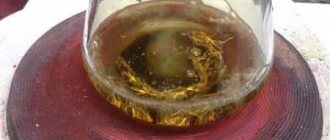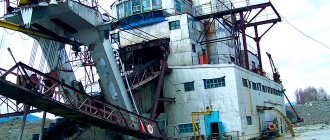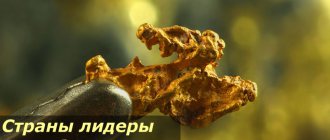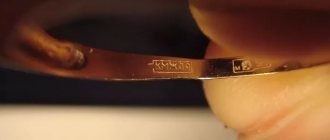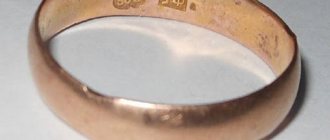For centuries, gold was considered the most valuable noble metal, which played a key role in a wide variety of areas of human activity.
But if in ancient times there were no specific methods for extracting this material, in addition to developing mines, then today things are much better and it is possible to extract a certain amount of gold from stone.
general information
Modern science knows which stones contain gold, so there are practically no difficulties with its extraction. Particles of precious metal are present in the veins of various rocks, and advanced technologies make it possible to determine their authenticity, as well as distinguish them from other, worthless materials.
In nature, gold can be found in the following forms:
- Nuggets.
- Fine-grained placers.
- Powder dust.
It is found in veins of stones and rocks, which are located in mountain rivers, among rocks and mountains, in sea sand, and also together with other minerals. Knowing which stones contain gold, you can remove it without much difficulty. The extraction of precious metal occurs through refining.
Before you start extracting it, you need to make sure that it is really a precious metal and not iron pyrite or zinc. Many minerals resemble yellow treasure with their characteristic shine, but they crumble very quickly under mechanical stress. As for gold-containing stones, they only scratch.
Fake gold sands and placers may look identical to pure gold, but they differ from it in a number of properties. The satellites of gold are intrusive rocks that were formed due to the solidification of magma.
Among them:
- Quartz diorites.
- Granite.
- Quartz.
The closest neighbors of the yellow metal are galerites, pyrites, stibnites, arsenopyrites and other similar minerals. Removing a valuable find from granite is incredibly difficult; this requires complex installations and professional equipment.
When figuring out how to extract gold from stone at home, you need to understand that mining methods may differ depending on its composition and other features. To accomplish this task, a lot of chemical methods are used. When processing lead sulfite, a mechanical action is carried out, which allows you to break the stone into small cubes, and then get the desired find from there.
Quartz diorites and quartz also have an impressive content of precious metal. They can be found in rocks, rivers and rocks, as well as in sea sand and on the pebbles of the bottom of various natural bodies of water. Tiny metal particles look like gold deposits.
Methods for extracting gold from stones
Once the presence of gold impurities in the ore is determined, the raw materials are sent to refineries. Here the ore is processed in various ways, purifying it from all kinds of impurities.
However, in Russia, for the exploration and further processing of ore, it is necessary to purchase special licenses. Otherwise, gold mining and processing will be prosecuted by law. Only licensed refineries have the right to put a sample on the received bars, which is the only confirmation of the authenticity of the precious metal.
In addition, it is quite difficult to obtain pure metal from stone. People have been working on extracting aurum from stone for centuries. And today refining has reached the peak of its capabilities.
There are three options for ore processing, but they all require special training and professional equipment.
Chemical method
In this case, ore processing involves the supply of aggressive acids. Depending on the composition of the alloys, chemists select the necessary acid, which, acting on the ore, dissolves base metals and other impurities. The noble metal remains intact and falls out in the form of sediment.
Dry method
The most labor-intensive method, requiring compliance with increased personnel safety measures.
In order to obtain noble metal using the dry method, you will need special equipment in which rocks are crushed into dust. Next, the gold-bearing dust is attacked by chlorine under high pressure. As a result, the stone dust turns into a gaseous state and makes it possible to extract gold particles untouched by chlorine.
Electrolysis method
Today, depending on the type of ore obtained and its composition, all three methods of gold extraction are used. However, the electrolysis method is gaining increasing popularity. It consists of passing a current through ore mixed with hydrochloric acid. As a result of the reaction, aurum particles precipitate.
Search for gold
How to find rock that may contain valuable yellow metal is not difficult to understand. The gold mining industry is developing in several countries where natural deposits of this rock are located. Among them:
- China, which ranks first in terms of gold mining volumes.
- Australia.
- Russian Federation.
- USA.
- Canada.
- SOUTH AFRICA.
- And some other countries where gold mining is carried out on a smaller scale.
Russia is in third place on the list, behind China and Australia in terms of precious metal production. Several deposits were found on the territory of the state, 95% of which are located in the regions of the Far East, in the Amur, Krasnoyarsk and Irkutsk regions, as well as in Chukotka. Gold is also mined in Buryatia, Transbaikalia, Khabarovsk and Krasnoyarsk territories. The latter region is considered the leader in terms of volumes of precious metal extraction from the ground.
How to choose the right place to search
Where can you find deposits? Before you start searching, find out where gold was mined and check them. Old mines, rivers and streams are suitable. Studying geological data and remembering the differences between important minerals - granite, slate and gneiss, quartz and feldspar - will help. They are almost always present in most places where aurum can be found.
Beginners should not try to find out how professionals search for such points - an independent search without knowledge and experience will most likely end in nothing.
Best place to mine
Of course, large deposits have already been explored by industrial enterprises, but gold can be found in areas that are of no value to holdings. Despite their small size, the content of Au and gold nuggets there is high, so they can be successfully mined.
Rich places in Russia
The forests of Siberia are considered a region rich in gold, where active study of soils and extraction of the resource is currently taking place. There a person can find a nugget by accident and not even realize it. The list also includes the Amur Region, Yakutia, Kolyma, and Krasnoyarsk Territory. Large mines are located in Norilsk.
You need to understand that all the places about which there is information in the public domain have long been occupied by industrial enterprises.
Identification of deposits in nature
In the era of free access to any information, it is not difficult to understand how to identify gold in a stone. But before that, you need to consider the list of the most promising places in which such a metal is likely to be present. Theoretically, particles of gold can be present in a wide variety of stones, but their quantity is so minute that it is not of particular value. If you want to engage in more serious mining, you need to count on luck and follow the principles of identifying deposits.
A small amount of the precious metal is found in sea water . Experts say that if all gold reserves are removed from the waters of the World Ocean, their quantity will reach 10 billion tons. The figure looks shocking, but modern science does not know any methods for extracting metal from the hydrosphere.
In its pure form, gold is extremely rare, especially when it comes to stones containing this noble metal. In most cases, yellow treasure is found along with various impurities that need careful processing. It is possible to find pure material in large quantities in quartz formations. Such formations are constantly exposed to wind and rain, which causes their destruction. As a result of this process, a single piece of gold nugget is formed.
Natural reserves of gold are also contained in the following deposits:
- Eluvial.
- Residual.
- Bottom.
- Terraced.
Residual deposits are observed near the vein itself, which was under physical or chemical influence. The eluvial type is found directly at the foot of the mountains.
Terrace deposits can be identified at the bottom of reservoirs, usually rivers, which erode the earth, forming an additional bottom. The old bottom layer turns out to be above ground level, which makes it look like a kind of terrace. And the older this terrace, the higher the likelihood of successfully identifying a large number of valuable reserves. Sediments end up at the bottom through precipitation, and under the influence of rain and currents they are washed ashore.
Patterns of high gold content in quartz veins at the Akbakai deposit
Key words: sample, vein, gold content, deposit, gold distribution, ore columns, fault, junctions
The relevance of this topic lies in the fact that patterns can serve as a basis for continuing prospecting and assessment work; taking them into account will increase the efficiency of geological exploration and lead to acceleration and saving of work, and will also make it possible to make new theoretical forecasts. The end result could be an expansion of the indigenous gold resource base.
The Akbakai gold deposit was discovered in 1969 by the Zhetysu gold mining expedition during a detailed search for gold (Duisenbekov D.D. et al.).
The Akbakai field area is part of the largest geological structure in Kazakhstan - the Chu-Balkhash anticlinorium. It includes the Zhalair-Naiman and Sarytum geosynclines, separated by the narrow Zheltau geoanticline. The main structure that determined the geological development and its metallogeny is the Jalair-Naiman zone of deep faults. The Akbakai deposit is localized at the junction of the Sarytum and Jalair-Naiman geosynclines. The main elements of the geological structure of the Akbakai field are:
1) host rocks of diorite-granodiorite composition, which are competent rocks for both sustained fracturing and hydrothermal-metasomatic ore formation;
2) manifestation in several stages of fractured discontinuous structures of systems 2 and 4;
3) intrusion of dike formations of different ages along cracks;
4) manifestation of a multi-stage hydrothermal process with gold deposition along fracture structures (zones).
The quartz veins of the Akbakai deposit carry out sub-latitudinal fractures and are controlled by dikes of lamprophyre composition. In total, 16 veins with balance ores of industrial categories have been explored at the deposit (Fig. 1).
Rice. 1. Layout of veins at the Akbakai deposit
According to the mineralogical composition of the ores, the Akbakai deposit belongs to the gold-sulfide-quartz formation. The main useful component is gold. According to its morphological features, occurrence conditions and internal structure, the deposit belongs to a low-thickness quartz vein, mineralized zones with disseminated mineralization and fine-veined silicification.
In general, the Akbakai deposit is characterized by sharp variability in the thickness and internal structure of mineral bodies, a very uneven distribution of the main valuable components and belongs to the 2nd group of complexity in accordance with the classification of reserves.
Migrating through the strata, the solution captured finely dispersed gold, transferring it into the composition of colloids, and became enriched with it as it moved further. Having reached the cavities of interlayer exfoliation, colloidal gold, through contraction, formed finely dispersed aggregates, which over time increased to the size of nuggets [3]. Under conditions of folding, the scale of the manifested kinetic and, therefore, thermal energy is large enough for the temperature of the solutions in the displaced zones to rise above the melting point of gold. Therefore, it can be assumed that nuggets are formed in a homogenized vapor-liquid medium by merging microdroplets of a former colloidal solution into nuggets under the action of surface tension forces. Currently [4] it is believed that the formation of nuggets occurs exclusively in gold-supersaturated quartz solutions with temperatures in the first hundreds of degrees. Further, residual water in granodiorites dissolved the quartz grains contained in them. The silicate solution thus obtained simultaneously filled the interlayer cavities with colloidal gold, thereby forming ore-bearing quartz veins.
During the formation of folding in rocks, favorable physical and chemical conditions are created for the formation of gold-quartz veins based on the hydrothermal process. Nuggets can also form under conditions of high temperatures, which ensure the melting of gold particles.
Considering in general terms the distribution of gold in the plane of ore bodies, it can be noted that their central parts are enriched. Against the background of this general pattern, local areas of rich ores stand out. Their sizes range from a few meters in diameter to 40–50 m, rarely more. The experience of operating the deposit has shown full compliance of the geological boundaries of the ore bodies with the actual observed ore distribution. Almost all increased concentrations of gold are concentrated within geological boundaries. Outside of them, weakly hydrothermally altered rocks contain, as a rule, up to 1.0 g/t gold (Fig. 2).
Rice. 2 Block model of the ore body of the Akbakai deposit
Against the background of a general inclination of mineralization to the west, ore columns (6 columns) were identified, the position of which was determined by a number of structural elements. The location of ore columns (sites), a number of defining structural elements and their parameters are given below:
− the area where the Glavnaya and Oktyabrskaya veins meet with a length of 25 m (20 m horizon between profiles XVI-XVII);
− area of connection between the vein and the lamprophyre dike, 65 m long (20 m horizon near profile XVII);
− area of intersection of the quartz vein dike of lamprphyres for 25 m (20 m horizon near profile XXII);
− the area where the vein intersects and is displaced by 5–6 m by two transverse discontinuities over a distance of 20 m (100 m horizon, west of profile XVIII);
− the area where the vein splits into two branches, the intersection of one of the branches of the lamprophyre dike, the intersection and displacement of the ore body by a fault over a section of 40.0 m (100 m horizon near profile XVIII-XX);
− the area of conjugation and intersection of the ore zone (vein, dike) with the granodiorite-porphyry dike and the presence of small transverse discontinuities with complications of the morphological structure of the vein in the places of conjugation and intersection.
In the described section of the vein, two ore columns were identified, associated with the intersection of a lamprophyre vein dike.
The first, not clearly defined column is located on the western side of the intersection, its length is about 60 m. Obviously, an ore column of a higher order is superimposed on it, controlled by a transverse discontinuity, the content in the vein itself reaches 167.5 g/t.
The second, very rich ore column is associated with the divergence of the ore vein and the dyke, and possibly with its splitting. Its length is 40 meters, the gold content is three and four digits. In the area of joint development of the vein and dike, the gold content corresponds to the average level for the vein. In addition to these ore columns, an increased gold content (6–8 g/t against the background of off-balance ores) was established at the intersection with the Frolovskaya vein (profile XXVII), which is non-industrial here.
Increased concentrations of gold begin at the junction with the Glavnaya vein (120 m drift). This segment of the ore body, which has a strike of 15–20°, is attributed by us to the Pologaya 1 vein. It is possible, however, that it is a continuation of the Tukenovskaya vein already in the hanging block of the Glavnaya vein.
The ores of the Akbakai deposit are divided into primary sulfide and weakly oxidized according to the degree of oxidation. Currently, the second type of ore is completely mined. In fact, the reserves remaining in the bowels are represented only by primary ores. The mineralogical composition of primary ores is quite simple. The main ore minerals are arsenopyrite, pyrite, gold, sphalerite, chalcopyrite, stibnite, galena, fahlore, of which the first two minerals account for more than 75% of their volume. The sulfide content in the upper horizons of the deposit is 7–10%, decreasing with depth along steeply dipping veins to 4–5% and in gently dipping veins to 1.5–2.5%.
As a study, laboratory tests were carried out on 13 samples, consisting of sieving the original ore into two fractions (+150 mesh, -150 mesh or +0.104 mm, -0.104 mm) and fire assay analysis of each ore fraction (Table 1). This technique is called screen analysis. The technique is used for samples with uneven distribution of gold. Samples were taken from exploration wells, 7 (seven) of which were taken from the central part, i.e., the area of rich ores, and 6 (six) from outside the central part, where samples with moderate gold content. Data from the first seven samples indicate different classes of gold fineness and its uneven distribution. Based on the next six samples, we can say that the samples contain fine gold, that is, small “invisible” gold in sulfides.
Table 1
Screen analysis data
Conclusion
It was noted above that a characteristic feature of the ore bodies of the Akbakai deposit is the presence within them of local areas characterized by high gold content. Such areas are called concentration ore pillars. When conducting detailed exploration, certain structural criteria are established that control them.
The most common pattern at the Akbakai deposit is the fact that the central parts of the veins are enriched in gold. Along the fall, rise and flanks, gold content gradually decreases.
The deposit has geological and structural elements of various types that control ore columns of different areal sizes. Large structural elements (West Akbakai Fault), contact of the Kyzylzhartas intrusion, some submeridional faults, areas of conjugation of steeply dipping veins on the western flank predetermine the western declination of both ore bodies and large columns within the steeply dipping Glavnaya, Frolovskaya and Zolotaya veins. The steep (50–60°) plunge of the ore columns to the west coincides with the dip of the above structural elements. The dihedral angle formed by the Western Akbakaysky and Beskempirsky faults has a southwestern plunge and may have been the direction along which melts and ore solutions circulated. The interface lines between the quartz veins and the Main vein are the second most important structural element, controlling the general direction of the ore columns. This control factor is clearly visible in the examples of the Oktyabrskaya and Tukenovskaya veins. In the flat Yubileinaya and Gentle 1 veins, the contours of rich ores are generally parallel to the lines of their junction with the Main vein.
Against the background of the general pattern of placement of rich ores and large columns, high-order ore columns stand out, which are often recorded by two to three intersections (length in plan up to 10 m), and sometimes more extended - from 20–40 to 60 m. They are controlled by the geological and structural elements listed below (in order of decreasing importance) or their combinations.
- Interfaces of quartz veins. Near the junctions and directly in them, one of the veins is enriched in gold, while the second vein is characterized by medium or even low gold content. Often, areas of industrial veins turn out to be rich when secondary, usually flat, veins approach them. The richest and most extensive is the ore column of the Yubileinaya-60 vein, which tends to be conjugate with the Pologaya 1 vein. The gold content of the latter vein in the conjugation area is low.
- Intersection of ore-controlling lamprophyre dikes by quartz veins. Ore columns are confined both directly to the intersections themselves and to the areas where the vein approaches the dike. In the latter case, they are somewhat longer.
- Transverse pre-ore faults are a widespread structural element. The associated ore columns have, with few exceptions, small areal sizes, but very high concentrations of gold.
- Areas where the morphology of ore bodies is complicated by bending of veins in plan or section and their splitting.
- Internal dikes. In total, two ore columns associated with intra-ore dikes were noted, but there could be significantly more of them.
Literature:
- Danilov V.I., Dursunov A.D. Report on geological exploration work at the Akbakai gold deposit for 1971–74. // Nikolaevka, 1974
- Yarensky Yu. E., Los V. L. Recalculation of reserves of the Akbakai deposit. Part I // Almaty, 2000
- Burakov A. M., Ermakov S. A., Blinov A. A. Forms of gold content and prospects for metal extraction from the sands of the Kuranakh buried placer. // Placers, sources, their genesis and prospects. — Materials of the conference dedicated to the 90th anniversary of the birth of I. S. Rozhkov and Yu. N. Trushkov. - Yakutsk: YSC SB RAS, 2000. - P. 196–201.
- Samusikov V.P. Gold nuggets - conditions for their formation (using the example of deposits of the Yana-Kolyma belt). // Notes of the Russian Mineralogical Society. - 2011, No. 4. - P. 38–55.
Extraction methods
One of the oldest, but also the most dangerous methods for extracting gold from stones is amalgamation. Today, the technique is officially prohibited in the Russian Federation, but continues to be in demand in other countries, as well as among “black” miners. To extract the precious metal, mercury is used, which is placed in a plastic or glass tray with existing sand and the smallest fractions of the yellow treasure.
It is known that mercury is not able to dissolve gold, but can draw it into its balls. To speed up the process, the gold miner regularly turns the tray, allowing the substance to roll completely over its entire surface.
Mercury beads combined with gold are called amalgam . After separating such a mixture from the sand, it is additionally treated with hydrochloric acid, which promotes the dissolution of mercury, but has no effect on gold. The method of evaporating toxic mercury under the influence of fire is also practiced. Similar manipulations were carried out directly in the frying pan. Once in the acid, the gold settles to the bottom in the form of flakes, after which it is subjected to deep washing. If you want to preserve mercury for further operations, a piece of foil is lowered into the acid. Thus, the mercury precipitates.
The next method of gold extraction, known since ancient times, is panning. Unlike the previous method, washing is considered completely safe for the body and does not harm the environment. The method is based on the special properties of the precious metal, namely its high density. Flushing is relevant for both industrial and private mining. It also continues to be practiced in placer deposits.
The technological process itself consists of washing the sand with water, as a result of which the light fractions are quickly removed, while the heavy fractions remain at the bottom. The disadvantage of this technique is that too small particles are washed out by water, which significantly reduces production productivity. When wondering whether it is possible to engage in private gold mining in this way, you need to pay attention to the relevant law. It involves the purchase of a prospector's license valid for up to five years.
Gold dredge
After many years, the technologies used to mine gold in ancient times have not changed much. All that has changed is the work of mechanized machines instead of human labor.
Today, few people are engaged in gold mining using trays, since this method is no longer relevant and widespread. But the technology has survived. Today, many people use a huge machine that has a large number of trays.
A dredge is a device used to flush water from a river. It is this huge and noisy structure that is capable of extracting precious metal from river rock. Although this method is very effective and profitable, it has a very negative impact on the environment. After dredging, river beds are left in a deplorable state. But in order to know how to find and then safely extract gold from the river, it is recommended to use dredging as the easiest way to mine gold.
Home techniques
Industrial gold mining differs significantly from private gold mining, and the methods used have many advantages. If you know how to identify gold in a stone, you can successfully remove it from there using the most primitive methods.
And you don’t have to go to distant Siberia in search of abandoned mines. You can implement the idea of withdrawing precious metals at home. Back in the days of the Soviet Union, skilled craftsmen extracted it from old watches and other yellow metal products. In the recent past, gold plating was present on many radio components and household appliances, which was justified by its practicality and resistance to corrosion. Without a doubt, the percentage of gold content in such objects is negligible, but in the rock it is not that high.
If you want to get the precious yellow material at home, just take an old wristwatch and then fill it with nitric acid in glass or plastic containers. The substance will quickly dissolve any materials except gold. The resulting solution must be carefully passed through several layers of gauze, and the seized gold must be infused in vodka for 24 hours. This will result in a brownish tint.
In the future, it is necessary to rinse the composition with plain water, filter again and put on low heat to melt. To improve the efficiency of the latter process, soda is added to the gold. We must not forget about the ability of the yellow metal to evaporate, but through melting it is cleared of excess impurities and becomes like a tiny ingot.
Gold can also be extracted from radio components , in which it was used back in the Soviet Union due to its inertness and minimal electrical conductivity. To implement such an idea, you need to use “regia vodka”, which consists of nitric and hydrochloric acid. Such a substance can dissolve gold at room temperature. By the way, there are historical facts about the dissolution of gold medals in order to hide them from the fascist military. Under the influence of aqua regia, gold precipitates, after which it is thoroughly filtered and washed.
Industrial gold mining technologies
Extracting minerals from the subsoil is a complex and strictly regulated process. In general, there are two methods of industrial mining of solar metal: open-pit mining and underground.
Open way
It is used when gold lies very close or comes to the surface. This is the most feasible method from an economic and environmental point of view. It looks like this: a huge depression in the ground with ribbons of roads and lifts. Rock is removed from the bowels of the earth using explosives and special heavy equipment. The machines deliver the necessary tools and transport the extracted ore. The costs of all this are very high. It is believed that the price of diesel fuel alone accounts for about 30% of the cost of gold mining.
In a good open pit mine, each ton of ore may contain about one-tenth of an ounce of metal (an ounce is equal to 31.1034768 grams). Based on the cost of an ounce of gold being $900, the cost of a ton of ore is $90. Considering that the carrying capacity of the vehicles used in the mines reaches 300 (or more) tons, a truck of ore can cost about $28. But the reality differs from expectations and calculations: during mining, some batches are richer than others, and many turn out to be dummies.
Closed method
When gold lies deep, underground mining is used. These are deep mines with a network of tunnels, each of them reaching the deposits. Here you need to drill holes into which explosives are placed, then pull out the rock fragments. Sometimes workers use jackhammers, shovels and carts, although, of course, this is a thing of the past. Modern gold mining uses explosives, powerful rock-loading machines, rail vehicles or huge trucks. Very rarely, natural conditions allow the use of the most effective self-propelled equipment, and then the number of people at this very labor-intensive and rather dangerous stage of production is reduced.
To ensure uninterrupted energy supply to such mines, wind or solar power plants are sometimes installed nearby, and if this is not possible, diesel generators are installed. Gold mines are very deep, which means ventilation is important, as is the transportation of people and rock. Without electricity, all this cannot be achieved.
As a rule, mines are located in areas difficult to live in, so the availability of electricity is always extremely important.
Historical facts
If you familiarize yourself with historical facts, you will know that during the times of Ancient Rus', the state had practically no gold deposits, despite its vast area. Prince Ivan III devoted a significant part of his life to the issue of searching for precious metals, because he was practically obsessed with the idea of \u200b\u200bsearching for treasures. To realize his dream, he even invited Italian specialists and allocated impressive sums. But the efforts were not justified; he managed to find only a small piece of gold, which was only enough to make a tiny cross.
After him, Ivan the Terrible began to actively search for yellow sand. To find the valuable metal, he even went to war against the Siberian settlements, but was also doomed to failure. A similar story happened with the rest of the rulers of Ancient Rus', until a turning point in the history of the state occurred. This was the rise to power of Peter I. The legendary ruler began to actively introduce clothing items and jewelry containing precious metals and valuable stones.
The first gold nugget was mined by a Ural peasant in 1945. This happened spontaneously while digging a hole. The happy owner of the precious stone immediately showed the find to a friend, who turned out to be a silversmith and confirmed the authenticity of the nugget.
The place where the find was discovered immediately attracted the attention of specialists, which led to the start of numerous search operations. However, they were unable to find anything, so work was suspended. Soon the authorities decided to resume the search and equip the mine. This decision paid off. At the bottom of the dug mine there was an impressive amount of gold reserves, which became the basis for large-scale gold mining.
Since ancient times, people have been interested in the idea of mining gold at home. Today, this trend is no less popular, only the methods of its implementation have changed significantly. Of course, you won’t be able to get rich through private gold mining, but finding a new hobby, as well as a little extra income, is quite possible.
Exogenous gold ores[edit | edit code]
Exogenous gold ores are concentrated in placers, less often in oxidation zones of gold-bearing sulfide deposits. Gold is found in the form of rolled and semi-rolled grains, flakes (size 0.5-4 mm), sometimes intergrowths with quartz in sand or clayey material containing boulders, pebbles and (or) crushed stone of various types. There are nuggets. Au content - from 100-150 mg/m³ to tens of g/m³, fineness - from 800 to 950. In oxidation zones, gold is concentrated in the lower parts of oxidized ores, mainly in association with iron and manganese hydroxides, with supergene minerals of copper, arsenic, silver, carbonates, kaolinite. Au content - from 2-3 to 10 g/t. Gold-bearing ores form complex deposits, lenses and nests.
Literature[edit | edit code]
- [www.mining-enc.ru/z/zolotye-rudy/ Gold ores] (article) // Mining Encyclopedia. Volumes 1-5, M.: Soviet Encyclopedia, 1984-1991
- Small mountain encyclopedia. In 3 volumes = Small Encyclopedia / (In Ukrainian).
Ed. V. S. Beletsky. - Donetsk: Donbass, 2004. - ISBN 966-7804-14-3. - Determining the amount of gold in ore using atomic absorption analysis - training video.
| Some external links in this article lead to sites listed as spam. These sites may infringe copyright, be considered non-authoritative sources, or be otherwise banned from Wikipedia. Editors should replace such references with references to compliant websites or bibliographic references to printed sources, or remove them (perhaps along with the content they support). List of problem domains |


